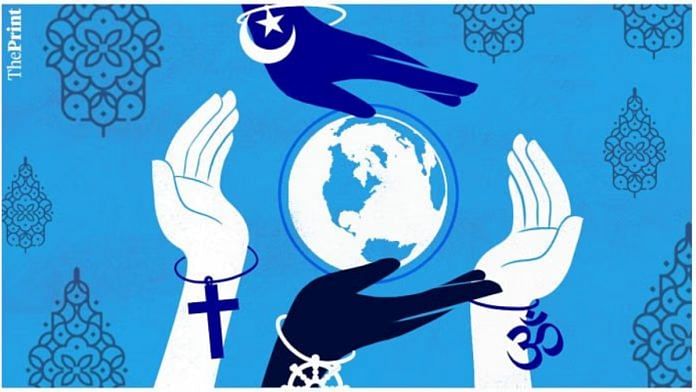New Delhi: Between 2010 and 2020, the world’s religious composition changed dramatically, according to a new survey from Pew Research Centre released on 9 June, 2025. While Islam was the fastest-growing religion, and Christianity saw its share of the global total decline, the biggest surprise of all was that the religiously unaffiliated—the ‘nones’—have become the third-largest group in this study.
Amidst all these dynamic changes the Hindu share of the world’s total remained strikingly stable, growing at about the same rate as the global population.
The Pew report, which uses information from more than 2,700 censuses and surveys conducted in 201 countries, demonstrates how births, deaths, migration, and switching religions combine in a complex way to transform the world’s demography.
Muslims became the most rapidly growing religion in the world during the decade under
review. Their population increased by 347 million, more than all other religions combined.
By 2020, their share of the world’s population increased by 1.8 percentage points to 25.6 percent. The majority of this growth is due to higher birth rates in countries where Muslims are already predominantly found.
With 122 million more Christians, they were the largest religion in the world in
2020, totaling 2.3 billion. Still, they did not grow at the same pace as the world’s
population. As a result, the share of Christians living in the world decreased by 1.8
percentage points to 28.8 percent.
There was also a significant geographic shift: for the first time, sub-Saharan Africa became home to more Christians than Europe. The higher Christian birth rates in Africa and high rates of Christian disaffiliation in western Europe are both factors.
The number of Buddhists was the only major religious group to completely decline. Their total population decreased to 324 million, a decline of 19 million. As a result, they
lost 0.8 percentage points to a share of 4.1 percent of the world’s population. Religious
disaffiliation in East Asian countries and very low Buddhist birth rates (who generally
live in countries with elderly populations) were the main reasons for the decline.
The Hindu population appeared to be strikingly stable. Between 2010 and 2020, the
number of Hindus around the world increased by 126 million, to approximately 1.2
billion. More importantly, their share of the world’s population remained relatively
constant at 14.9 percent. This appears to indicate that, during this time, the growth rate of the Hindu population was about the same as the global population.
Furthermore, the rate of “religious switching”—the number of persons who convert into
or out of Hinduism—is also relatively small. Roughly one person out of every 100 adults
who were raised Hindu left Hinduism, and a similar proportion of people from other
religious backgrounds converted into Hinduism.
This low net conversion helps to keep the demographic status quo.
About 95 percent of the world’s Hindus still reside in India, and the vast majority (99 percent) still live in the Asia-Pacific area. Small increases in North America and Middle East-North Africa more than offset the 0.2 percentage-point decrease in the total Hindu proportion for the Asia-Pacific region. Hindus moved to these regions in pursuit of economic opportunity, and this was the primary driver of the increases in these regions.
The fastest-growing Hindu populations were in North America (up 55 percent to 3.6 million) and the Middle East-North Africa (up 62 percent to 3.2 million). The Europe region also registered a substantial increase (up 30 percent to 2.2 million).
One of the most striking trends is the dramatic growth in the number of the religiously unaffiliated, the ‘nones’ which include atheists, agnostics, and others who don’t identify with any religion. Their number increased by 270 million, to 1.9 billion, and they now account for about a quarter of the world’s population, making them the third largest group after Christians and Muslims.
What’s especially remarkable about the growth of the ‘nones’, as the Pew report notes,
is that they tend to be less fertile and on average older, which usually means they’re at
a disadvantage when it comes to population growth. The main reason for the increase, especially in Western countries, is religious ‘switching’—people giving up their religion after they’ve been raised as Christians. It’s changed the demographic composition of many countries.
All other religions added up together (including Baha’is, Daoists, Jains, Sikhs, followers
of folk religions, and many more) grew to the same extent as the rest of the world, and
their share of the world’s population stayed the same (at 2.2 percent).
Mannat Kaur is an intern with ThePrint
(Edited by Viny Mishra)
Also read: 60-64% Americans still identify as Christian, 70% believe in an afterlife, finds latest Pew survey





This article from.M. Kaur on Pew Research statistics of Nones’ growth is a delightful and useful read. A thorough no-nonsense to the point article.
No baiting, no lengthy intro before getting to the point.